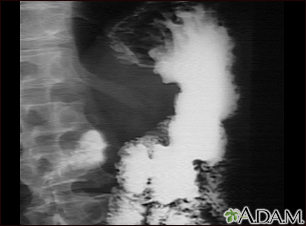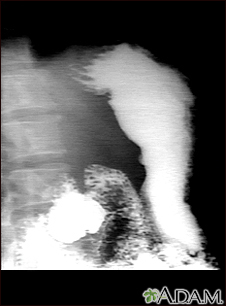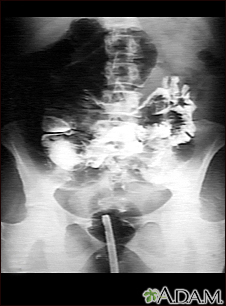Upper GI and small bowel series
GI series; Barium swallow x-ray; Upper GI series; Small bowel follow through
An upper GI and small bowel series is a set of x-rays taken to examine the esophagus, stomach, and small intestine.
Barium enema is a different test that examines the large intestine.
Images





I Would Like to Learn About:
How the Test is Performed
An upper GI and small bowel series is done in a radiology department.
You may get an injection of a medicine that slows muscle movement in the small intestine. This makes it easier to see the structures of your organs on the x-rays.
Before the x-rays are taken, you must drink 16 to 20 ounces (480 to 600 milliliters) of a milkshake-like drink. The drink contains a substance called barium, which shows up well on x-rays.
An x-ray method called fluoroscopy tracks how the barium moves through your esophagus, stomach, and small intestine. Pictures are taken while you sit or stand in different positions.
The test most often takes around 3 hours but can take as long as 6 hours to complete.
A GI series may include this test or a barium enema.
How to Prepare for the Test
You may have to change your diet for 2 or 3 days before the test. In most cases, you will not be able to eat for a period of time before the test.
Be sure to ask your health care provider if you need to change how you take any of your medicines. Often you can continue taking the medicines you take by mouth. Never make any changes in your medicines without first talking to your provider.
You will be asked to remove all jewelry on your neck, chest, or abdomen before the test.
How the Test will Feel
This test may cause mild bloating but no discomfort most of the time. The barium milkshake feels chalky as you drink it.
Why the Test is Performed
This test is done to look for a problem in the structure or function of your esophagus, stomach, or small intestine.
Normal Results
A normal result shows that the esophagus, stomach, and small intestine are normal in size, shape, and movement.
A normal result may vary depending on your overall health. Talk to your provider about the meaning of your specific test results.
What Abnormal Results Mean
Abnormal results in the esophagus may indicate the following problems:
- Achalasia
- Diverticula
- Esophageal cancer
- Esophageal narrowing (stricture) - benign
- Hiatal hernia
- Ulcers
Abnormal results in the stomach may indicate the following problems:
- Gastric cancer
- Gastric ulcer - benign
- Gastritis
- Polyps (a tumor that is usually noncancerous and grows on the mucus membrane)
- Pyloric stenosis (narrowing)
Abnormal results in the small intestine may indicate the following problems:
- Diverticulosis
- Malabsorption syndrome
- Narrowing (stricture)
- Swelling and irritation (inflammation) of the small intestines
- Tumors
- Ulcers
The test may also be done for the following conditions:
- Annular pancreas
- Duodenal ulcer
- Gastroesophageal reflux disease
- Gastroparesis
- Intestinal obstruction
- Lower esophageal ring
- Primary or idiopathic intestinal pseudo-obstruction
Risks
You are exposed to a low level of radiation during this test, which carries a very small risk for cancer. X-rays are monitored and regulated to provide the minimum amount of radiation exposure needed to produce the image. Most experts feel that the risk is low compared with the benefits.
Pregnant women should not have this test in most cases. Children are more sensitive to the risks for x-rays.
Barium may cause constipation. Talk to your provider if the barium has not passed through your system by 2 or 3 days after the exam.
Considerations
After this test, the barium that remains in the body may block details in other imaging tests. For this reason, other imaging tests may be done first.
Related Information
X-rayBarium enema
Esophageal cancer
Esophageal stricture - benign
Hiatal hernia
Diverticulitis
Ulcers
Achalasia
Stomach cancer
Mucosa
Gastritis
Pyloric stenosis in infants
Malabsorption
Crohn disease
Alcoholic neuropathy
Annular pancreas
CMV - gastroenteritis/colitis
Cystic fibrosis
Peptic ulcer
Gastroesophageal reflux disease
Gastroparesis
Intestinal obstruction and Ileus
Lower esophageal ring
Ovarian cancer
Intestinal pseudo-obstruction
References
Agosto O, Dass C, Caroline DF. The stomach. In: Adam A, Dixon AK, Gillard JH, Schaefer-Prokop CM, eds. Grainger & Allison's Diagnostic Radiology. 7th ed. Philadelphia, PA: Elsevier; 2021:chap 20.
Al Sarraf AA, McLaughlin PD, Maher MM. The small intestine, mesentery and peritoneal cavity. In: Adam A, Dixon AK, Gillard JH, Schaefer-Prokop CM, eds. Grainger & Allison's Diagnostic Radiology. 7th ed. Philadelphia, PA: Elsevier; 2021:chap 21.
Carucci LR. Diagnostic imaging procedures in gastroenterology. In: Goldman L, Cooney KA, eds. Goldman-Cecil Medicine. 27th ed. Philadelphia, PA: Elsevier; 2024:chap 119.
BACK TO TOPReview Date: 10/30/2024
Reviewed By: Jenifer K. Lehrer, MD, Gastroenterologist, Philadelphia, PA. Review provided by VeriMed Healthcare Network. Also reviewed by David C. Dugdale, MD, Medical Director, Brenda Conaway, Editorial Director, and the A.D.A.M. Editorial team.

Health Content Provider
06/01/2025
|
A.D.A.M., Inc. is accredited by URAC, for Health Content Provider (www.urac.org). URAC's accreditation program is an independent audit to verify that A.D.A.M. follows rigorous standards of quality and accountability. A.D.A.M. is among the first to achieve this important distinction for online health information and services. Learn more about A.D.A.M.'s editorial policy, editorial process and privacy policy. A.D.A.M. is also a founding member of Hi-Ethics. This site complied with the HONcode standard for trustworthy health information from 1995 to 2022, after which HON (Health On the Net, a not-for-profit organization that promoted transparent and reliable health information online) was discontinued. |
The information provided herein should not be used during any medical emergency or for the diagnosis or treatment of any medical condition. A licensed medical professional should be consulted for diagnosis and treatment of any and all medical conditions. Links to other sites are provided for information only -- they do not constitute endorsements of those other sites. © 1997- 2025 A.D.A.M., a business unit of Ebix, Inc. Any duplication or distribution of the information contained herein is strictly prohibited.
